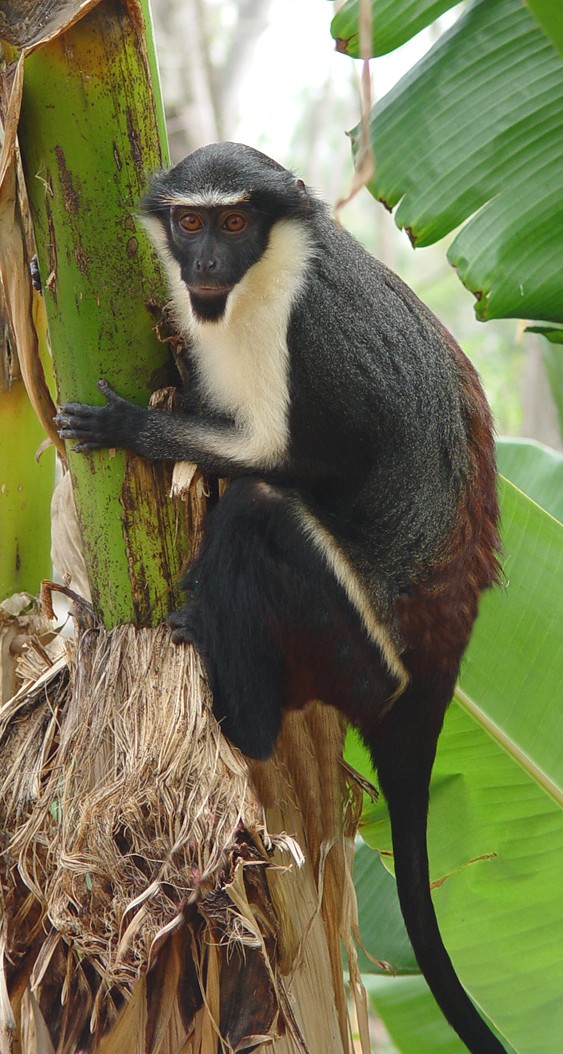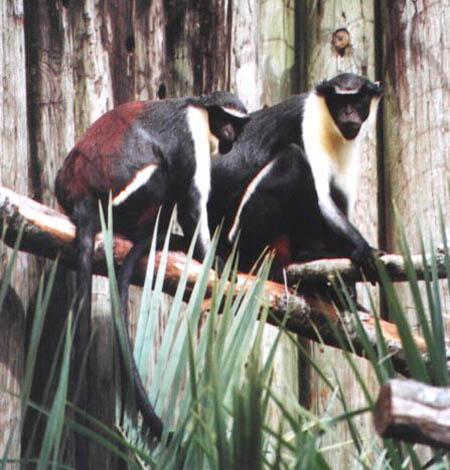Diana Monkey

Also Known as the Roloway Monkey
Diana monkeys have marked colouration which allows a wide range of visual social signals and they also have a wide range of alarm calls, with different sounds for different predators. Diana monkeys emit different grunts and low croaks, but the cry of the Diana has been described as yowling. They also communicate with facial expressions and head movements.
Diana monkeys feed mainly on fruit and insects, however, they will also take flowers, young leaves and invertebrates. Diana monkeys can pack their cheek pouches with the equivalent of about a stomachs load of food. This allows these monkeys to load up on food in places of danger or competition, then move on to a more secure location to eat. If the cheek pouches are full, the back of the hand is used to push food to the rear of the pouch. Food is very carefully processed (peeled, etc.) by hand and mouth to increase the quality and digestibility in the items swallowed.
In good conditions, adult females reproduce yearly. Gestation lasts about 5 months and the young nurse from their mother for a further six months. Only a single infant is born. Although the young are born in a fairly well developed condition, with open eyes and able to grasp their mother. Diana Monkey mothers appear anxious and possessive, rarely letting young infants leave them. As infants grow, however, they become very playful. Juveniles reach sexual maturity at an age of about 3 years. Daughters remain in their mothers' social groups, while males leave their natal groups shortly before attaining sexual maturity.. Diana monkeys may live for up to 20 years in the wild. Their life span in captivity is 22 years.
(Taken from: http://www.animalcorner.co.uk/wildlife/monkeys/owdrydiarolgtspot.html)
Check out these links and find some information about cute little guy!!

Also Known as the Roloway Monkey
The Diana Monkey (Cercopithecus diana) is
often considered one of the most beautiful of the Old World monkeys. The Diana
monkey is found in West Africa, from Sierra Leone to Ghana. The Diana monkey
inhabits the primeval forests, but does not thrive in secondary forests. It is
active during the day. It rarely comes down to the ground, but feeds at all
levels of the canopy, retreating to the upper levels of the trees at night,
though it does not make nests.
The Diana Monkey ranges from 40 to 55cm in length, excluding its tail, which is 3 – 4cm in diameter and 50 – 75cm long. Diana Monkeys are generally black or dark grey, they have a white throat, crescent-shaped brow band, ruff and beard. The brow band gives the species its common name, since it was held to resemble the bow of the goddess Diana. The Diana Monkeys underarms are also white and they have a white stripe down their thighs, while the backs of their thighs and their lower backs are a chestnut colour. Apart from the brow band, ruff and bear, and some fringes on their limbs, their fur is short and sleek in appearance. Adults weigh between 4 and 7kg.

Diana monkeys usually live in
small groups. The size of the group may reach 30. There is usually only
one adult male, two or three adult females and up to eight young. The
male Diana monkey will not tolerate another adult male and warns them
off with a head bobbing signal. When not resting during the hot noon
hours, the group moves along calmly. A groups territory may encompass
0.19 to 0.38 square miles. Feeding and grooming is done in the safety
of the middle to the high canopy of forests.
Diana monkeys have marked colouration which allows a wide range of visual social signals and they also have a wide range of alarm calls, with different sounds for different predators. Diana monkeys emit different grunts and low croaks, but the cry of the Diana has been described as yowling. They also communicate with facial expressions and head movements.
Diana monkeys feed mainly on fruit and insects, however, they will also take flowers, young leaves and invertebrates. Diana monkeys can pack their cheek pouches with the equivalent of about a stomachs load of food. This allows these monkeys to load up on food in places of danger or competition, then move on to a more secure location to eat. If the cheek pouches are full, the back of the hand is used to push food to the rear of the pouch. Food is very carefully processed (peeled, etc.) by hand and mouth to increase the quality and digestibility in the items swallowed.
In good conditions, adult females reproduce yearly. Gestation lasts about 5 months and the young nurse from their mother for a further six months. Only a single infant is born. Although the young are born in a fairly well developed condition, with open eyes and able to grasp their mother. Diana Monkey mothers appear anxious and possessive, rarely letting young infants leave them. As infants grow, however, they become very playful. Juveniles reach sexual maturity at an age of about 3 years. Daughters remain in their mothers' social groups, while males leave their natal groups shortly before attaining sexual maturity.. Diana monkeys may live for up to 20 years in the wild. Their life span in captivity is 22 years.
Check out these links and find some information about cute little guy!!